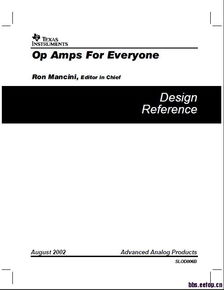Op Amps for Everyone: A Comprehensive Guide by Ron Mancini
Op amps, or operational amplifiers, are fundamental components in electronic circuits. They are versatile, powerful, and widely used in various applications. If you’re new to the world of op amps or looking to deepen your understanding, Ron Mancini’s “Op Amps for Everyone” is an invaluable resource. This article will delve into the intricacies of op amps, their applications, and the insights provided by Mancini’s book.
Understanding Op Amps

Before diving into the book, it’s essential to have a basic understanding of what an op amp is. An op amp is an electronic device with two input terminals and one output terminal. It amplifies the voltage difference between its two inputs. The book starts by explaining the basic principles of op amps, including their internal structure and how they work.
One of the key aspects Mancini emphasizes is the concept of negative feedback. Negative feedback is a technique used to stabilize the output of an op amp. It involves taking a portion of the output signal and feeding it back to the inverting input terminal. This process helps in reducing the gain of the op amp and improving its performance.
Applications of Op Amps

Op amps have a wide range of applications in electronic circuits. Mancini’s book covers various applications, including amplifiers, filters, oscillators, and more. Let’s take a look at some of the key applications discussed in the book:
| Application | Description |
|---|---|
| Amplifiers | Op amps are used to amplify weak signals, making them suitable for various applications such as audio amplification, sensor signal conditioning, and data acquisition. |
| Filters | Op amps are used to design filters, which can remove unwanted noise from signals or extract specific frequencies from a mixture of signals. |
| Oscillators | Op amps can be used to create oscillators, which generate periodic signals with specific frequencies and waveforms. |
| Comparators | Op amps are used as comparators to compare two voltages and provide a digital output based on the comparison result. |
Mancini’s book provides detailed explanations of each application, along with practical examples and circuit diagrams to help readers understand how to implement these applications in real-world scenarios.
Designing with Op Amps

One of the strengths of Mancini’s book is its focus on designing circuits using op amps. The book covers various design techniques, including the selection of appropriate op amps, biasing, and compensation. Mancini emphasizes the importance of understanding the specifications of op amps and how they affect circuit performance.
Additionally, the book discusses the limitations of op amps and how to overcome them. For instance, Mancini explains how to deal with issues such as input offset voltage, bias current, and power supply rejection ratio. This knowledge is crucial for designing reliable and efficient circuits.
Practical Tips and Tricks
Mancini’s book is filled with practical tips and tricks for working with op amps. These tips can help readers avoid common pitfalls and improve their circuit designs. Some of the key tips include:
- Using a breadboard to prototype circuits before building them on a printed circuit board (PCB).
- Using a multimeter to measure voltages and currents in the circuit.
- Using a scope to observe the behavior of the circuit.
- Understanding the importance of component tolerances and how they affect circuit performance.
These tips are invaluable for both beginners and experienced engineers looking to improve their skills in designing circuits with op amps.
Conclusion
Ron Mancini’s “Op Amps for Everyone” is a comprehensive guide that covers the basics and advanced aspects of op amps. Whether you’re a beginner or an experienced engineer, this book is an excellent resource for learning about op amps and their applications. By following the insights and practical tips provided in the book, you’ll be well-equipped to design and implement circuits using op amps with confidence.








